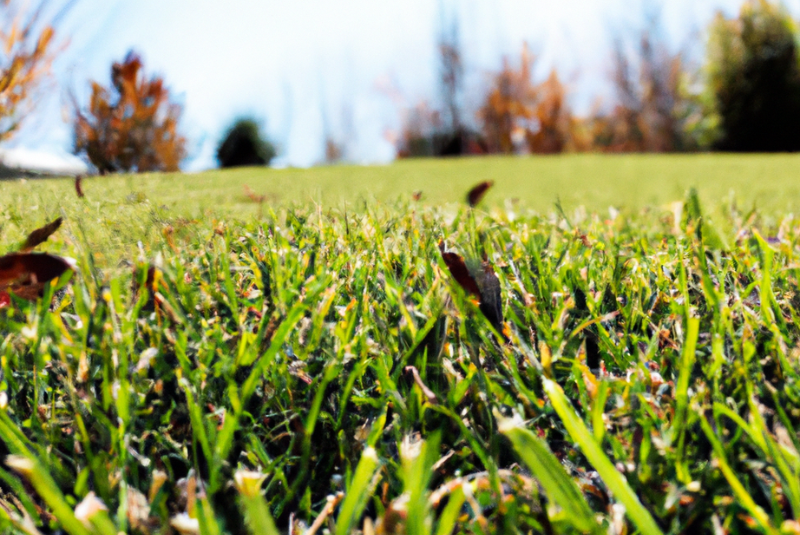Turfgrass management is a year-round endeavor, with each season presenting unique challenges and opportunities. One of the most critical periods in turfgrass management is the fall season. Fall fertilization, in particular, plays a pivotal role in preparing the turf for winter dormancy and ensuring a healthy, vibrant lawn in the spring. We will explore the benefits of fall turf fertilization, highlighting its impact on root development, nutrient storage, disease resistance, and overall turf health.
1. Root Development
One of the primary benefits of fall fertilization is the promotion of root growth and development. During the fall, while the growth of the grass blades slows down, the turf’s root system continues to grow. Applying fertilizer at this time provides the necessary nutrients for this root growth. A robust root system allows the turf to absorb water and nutrients more efficiently, enhancing its resilience against stress and promoting healthier growth in the spring.
2. Nutrient Storage
Fall fertilization also aids in nutrient storage, preparing the turf for the upcoming winter dormancy. As the temperatures drop, the turf begins to store nutrients in its roots for use during the winter and the following spring. By fertilizing in the fall, turf managers can ensure that the grass has an ample supply of nutrients to draw upon during these critical periods. This nutrient storage can result in a quicker green-up in the spring, giving the turf a head start on growth. Turf utilizes nutrients during the fall for building carbohydrates. Fall carbohydrate development helps the plant cope with cold temperature extremes and promotes healthy turf conditions the following spring.
3. Disease Resistance
Disease resistance is another significant benefit of fall fertilization. Diseases can be particularly damaging to turfgrass, especially during the stress of winter. Fall fertilization can help to strengthen the turf’s defenses against these diseases. By providing the necessary nutrients, fall fertilization can enhance the turf’s overall health and vitality, making it less susceptible to disease. Furthermore, certain nutrients, such as potassium, can directly enhance the turf’s disease resistance. Potassium strengthens the cell walls of the grass, making it more difficult for pathogens to invade.
4. Weed Suppression
Fall fertilization can also aid in weed suppression. A healthy, well-fertilized lawn can outcompete many common weeds, reducing their ability to establish and spread. By ensuring that the turf has the nutrients it needs to grow thick and lush, fall fertilization can create a natural barrier against weed invasion. This can reduce the need for herbicides, making turf management more environmentally friendly.
5. Recovery from Summer Stress
Summer can be a stressful period for turfgrass, with high temperatures, drought, and heavy foot traffic all taking their toll. Fall fertilization can help the turf recover from this stress. By replenishing the nutrients that have been depleted over the summer, fall fertilization can restore the turf’s health and prepare it for the challenges of winter. This recovery period can be crucial for the long-term success of the turf.
6. Improved Color and Density
Fall fertilization can improve the color and density of the turf. Nitrogen can enhance the turf’s color, giving it a vibrant, healthy appearance. At the same time, fall fertilization can promote denser growth, resulting in a thicker, more lush lawn. This can enhance the aesthetic appeal of the turf, making it a more enjoyable space for Fall outdoor living.
Fall fertilization plays a crucial role in turfgrass management. By promoting root development, aiding in nutrient storage, enhancing disease resistance, suppressing weeds, aiding recovery from summer stress, and improving color and density, fall fertilization can significantly enhance the health and appearance of the turf. While the specific fertilization needs may vary depending on the type of grass and local soil conditions, the benefits of fall fertilization are universal.
It’s important to note that the success of fall fertilization also depends on using the right type and amount of fertilizer. A soil test can provide valuable information about the soil’s nutrient levels and pH, helping turf managers choose the most appropriate fertilizer. Typically, a fall fertilizer should be composed of more than one nitrogen source to promote both quick release and slow release. Potassium is needed to enhance disease resistance and winter hardiness. Hudson Valley Natural fertilizers contain 5 sources of Nitrogen and Potassium Sulfate to not only prepare your turf for winter, but also aide in spring green-up. Timing of fall fertilization is crucial. It should ideally be done when the grass is still actively growing but the temperatures have cooled down. This allows the turf to take up and store the nutrients before the onset of winter dormancy.
Finally,
Contact your local Central sales representative for Hudson Valley Natural products. Whether you have fertilizer, chemical, or seed questions the Central team is here to help! Our team has decades of experience in agronomics and turf management. As a strategic partner, Central can work with you to create plans that produce healthy turf for you and your customers that are efficient and profitable.

